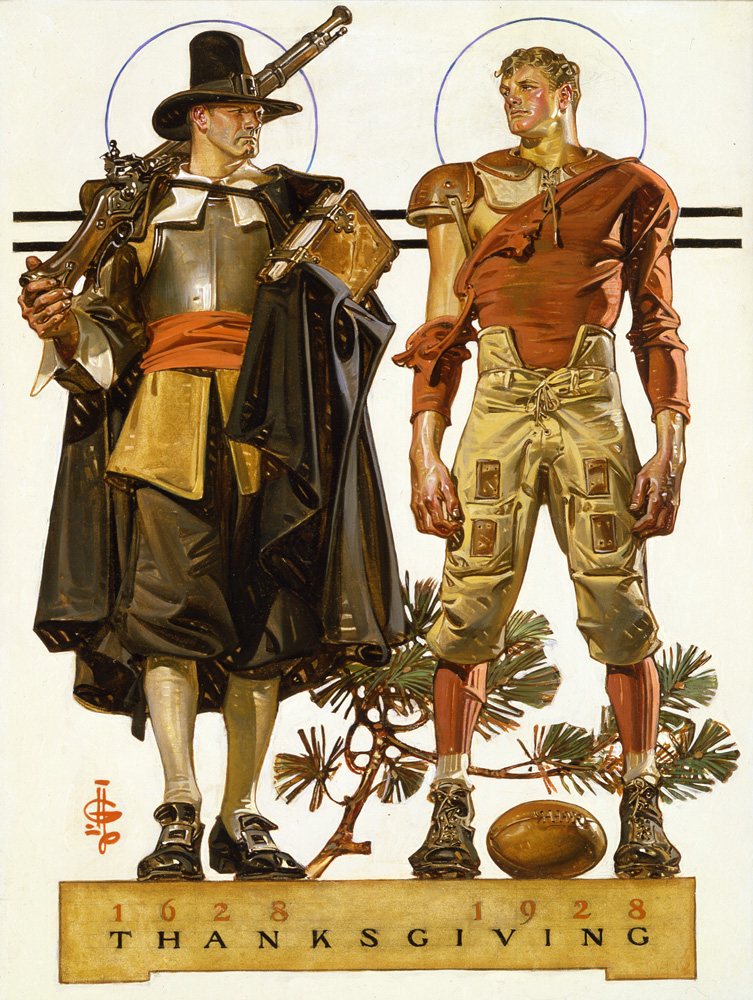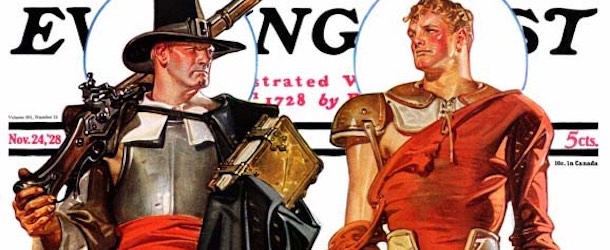How one of America's most famous illustrators brought homoerotic ads to the masses
“Sex sells” is one of the oldest aphorisms in advertising. But it wasn’t until the turn of the 20th century that the marketing world truly took notice of the male form. In large part, that was thanks to the work of commercial illustrator J.C. Leyendecker, whose ads were suffused with homoeroticism.
Leyendecker painted broad-chested Adonises that were used to sell everything from socks and underwear to razors and cigarettes. His most notable contribution, though, was the “Arrow Collar Man,” a dashing figure who promoted Cluett Peabody & Company’s removable shirt collars.
Leyendecker also painted 322 covers for the Saturday Evening Post, reportedly one more than his famous protégé, Norman Rockwell. From the 1900s to the 1930s, he was a household name: Both Leyendecker and the Arrow Collar Man were name-checked by F. Scott Fitzgerald.
But with the advent of the Great Depression and World War II, his urbane, effete mannequins fell out of favor.

J.C. Leyendecker (J.C. Leyendecker / National Museum of American Illustration)
© J.C. Leyendecker

J.C. Leyendecker (J.C. Leyendecker / National Museum of American Illustration)
© J.C. Leyendecker
more...
mahatmakanejeeves
(64,568 posts)Thu Nov 24, 2022: On Saturday, November 24, 1928, this was the cover of the Saturday Evening Post:

More about J.C. Leyendecker and his illustrations in the Saturday Evening Post:
Cover Collection: J.C. Leyendecker’s Thanksgiving
Famed artist J. C. Leyenedecker always had a unique point of view. Who else would have dared paint a “butcher baby” for Thanksgiving?

{snip}
More about J. C. Leyendecker:
Sun Jun 20, 2021: What Was The First Gay Ad?
Sun Jun 20, 2021: J. C. Leyendecker would likely have illustrated many an early contender.
Hat tip, The Boys of Fairytown

Leyendecker in 1895
Born: Joseph Christian Leyendecker; March 23, 1874; Montabaur, Rhine Province, German Empire
Died: July 25, 1951 (aged 77); New Rochelle, New York, U.S.
Joseph Christian Leyendecker (March 23, 1874 – July 25, 1951) was a German-American illustrator. He is considered to be one of the preeminent American illustrators of the early 20th century. He is best known for his poster, book and advertising illustrations, the trade character known as The Arrow Collar Man, and his numerous covers for The Saturday Evening Post. Between 1896 and 1950, Leyendecker painted more than 400 magazine covers. During the Golden Age of American Illustration, for The Saturday Evening Post alone, J. C. Leyendecker produced 322 covers, as well as many advertisement illustrations for its interior pages. No other artist, until the arrival of Norman Rockwell two decades later, was so solidly identified with one publication. Leyendecker "virtually invented the whole idea of modern magazine design."
{snip}
Early life
Joseph Christian Leyendecker ('J.C.' or 'Joe') was born on March 23, 1874, at Montabaur in western Germany, a tiny village 18 km east of the Rhine, to Peter Leyendecker (1838–1916) and Elizabeth Ortseifen Leyendecker (1845–1905). Joseph was the first-born son, and his brother Francis Xavier was born three years later. A sister, Mary Augusta, the third and last child, arrived after the family emigrated to America.
{snip}
After studying drawing and anatomy under John H. Vanderpoel at the Chicago Art Institute, J. C. and younger brother Frank enrolled in the Académie Julian in Paris for a year, where they were exposed to the work of Toulouse-Lautrec, Jules Chéret, and also Alphonse Mucha, a leader in the French Art Nouveau movement.
Career
In 1899, the Leyendecker brothers returned to America and set up residence in an apartment in Hyde Park, Illinois. They had a studio in Chicago's Fine Arts Building at 410 South Michigan Ave. On May 20 of that year, Joe received his first commission for a Saturday Evening Post cover – the beginning of his forty-four-year association with the most popular magazine in the country. Ultimately he would produce 322 covers for the magazine, introducing many iconic visual images and traditions including the New Year's Baby, the pudgy red-garbed rendition of Santa Claus, flowers for Mother's Day, and firecrackers on the 4th of July.
{snip}
Personal life
Many biographers have speculated on J. C. Leyendecker's sexuality, often attributing the apparent homoerotic aesthetic of his work to a homosexual identity. Without question, Leyendecker excelled at depicting male homosocial spaces (locker rooms, clubhouses, tailoring shops) and extraordinarily handsome young men in curious poses or exchanging glances. Leyendecker never married, and he lived with another man, Charles Beach, for much of his adult life. Beach was the original model for the famous Arrow Collar Man and is assumed to have been his lover.
While Beach often organized the famous gala-like social gatherings that Leyendecker was known for in the 1920s, he apparently also contributed largely to Leyendecker's social isolation in his later years. Beach reportedly forbade outside contact with the artist in the last months of his life.
{snip}

Weapons for Liberty – U.S.A. Bonds. An appeal to youth to sell war bonds through a scene of a Boy Scout lifting a sword toward Lady Liberty, by Leyendecker.
{snip}
Legacy
Leyendecker's Beat-up Boy, Football Hero, which appeared on the cover of The Saturday Evening Post on November 21, 1914, sold for $4.12 million on May 7, 2021. The previous world record for a J. C. Leyendecker original was set in December 2020, when Sotheby's sold his 1930 work Carousel Ride for $516,100.
{snip}
Gallery

Arrow Shirt ad from the 1920s

Drawing from 1913
{snip}
See also
Frank Xavier Leyendecker
{snip}
The Oarsmen of J.C. Leyendecker: Homeric or Homoerotic?

A 1932 edition of the American Saturday Evening Post magazine. Strangely, the conservative, anti-New Deal, and middle class family orientated publication had what is (to most modern eyes at least) a sexualised ‘gay’ image of the U.S. Olympic Eight on its cover, painted by the illustrator, J.C. ‘Joe’ Leyendecker. This was not the only time that Leyendecker put semi-naked men on a pedestal.
{snip}

A sporting ‘homosocial space’ as depicted by Leyendecker.
{snip}

Leyendecker’s illustration for a magazine cover for Thanksgiving 1928 (many American Football games are traditionally played on that holiday).
{snip}
Aristus
(69,869 posts)I captioned it: "I...I'm sorry, dearest. I just don't know how to tell her..."
